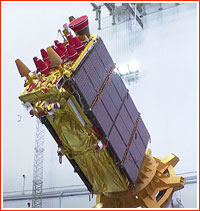|
||||||||||||||||||
Fourth GLONASS-K satellite lifts off Russia launched a fresh satellite to replenish its dual-use navigation constellation. The GLONASS-K No. 16 satellite lifted off on a Soyuz rocket from Plesetsk launch site on July 7, 2022.
GLONASS-K No. 16L mission at a glance:
Fourth GLONASS-K mission GLONASS-K No. 16L became the fourth satellite in the latest upgrade of Russian navigation satellites, designed to replace an older version, known as GLONASS-M, whose production had been discontinued. It reached the launch pad around 1.5 years after its predecessor, which was a major progress comparing to the six-year gap that had passed between the launches of the second and third satellites, resulting from the first round of Western sanctions imposed after the Russian invasion of Crimea in 2014. At the same time, GLONASS-K No. 16 was completed in the Fall of 2021, or before the new export ban, which was introduced in the wake of the large-scale Russian invasion of Ukraine on Feb. 24, 2022, and whose effects were yet to be assessed. At the time, there were eight GLONASS-K and four GLONASS-K2 satellites undergoing assembly at ISS Reshetnev in Zheleznogorsk and the head of Roskosmos Dmitry Rogozin promised the launch of "several" GLONASS-K and K2 satellites in 2022. The company reported completion of electric tests on its latest GLONASS-K vehicle in October 2020, followed by thermal and vacuum tests reported between February and March 2021. More electric tests and radio tests in an anechoic chamber were reported in June 2021. The fully assembled bird then proceeded to vibration and transportation tests before actual shipment to the launch site in Plesetsk, which was confirmed in mid June 2022. Flight profile The liftoff of the Soyuz 2-1b/Fregat rocket with the fourth GLONASS-K satellite took place as scheduled on July 7, 2022, at 12:18:06.211 Moscow Time (5:18 a.m. EDT) from Site 43 in Plesetsk. (In case of a 24-hour delay, there was a backup launch window on July 8, 2022, at 12:14:02 Moscow Time.) Several minutes after the fact, the Russian military confirmed through the official media that the pre-launch operations and the liftoff of the GLONASS-K had proceeded as planned. The assets of the Titov Chief Test Center of the Russian Air and Space Forces, VKS, began tracking the vehicle, the Ministry of Defense said. The latest launch of GLONASS-K likely emulated the flight profile of the previous missions. Under that scenario, after several seconds of vertical ascent, the launch vehicle heads southeast to align its ground track with an orbit inclined 64.77 degrees toward the Equator. The four boosters of the first stage separate around two minutes into the flight. Around 45 seconds later, the payload fairing protecting the satellite is commanded to split into two halves and drops off right after the vehicle exits the discernible atmosphere. The second (core) stage of the rocket continues firing until around 4.7 minutes into the flight, separating moments after the ignition of the RD-0124 engine on the third stage. Seconds later, the cylindrical aft section of the third stage splits into three segments and separates as well. The third stage of the rocket completes its powered ascent and separates from the payload section nine minutes and 22 seconds after liftoff. Flying just short of orbital velocity, the nearly empty booster naturally reenters the Earth's atmosphere near the opposite side of the Earth from the launch site, with its flaming remnants projected to fall into the southern section of the Pacific Ocean. Space tug maneuvers During a typical GLONASS mission, the Fregat-M upper stage conducts three orbital maneuvers to deliver the spacecraft to its operational circular orbit more than 19,000 kilometers above the Earth's surface. The first firing of the Fregat's main engine, lasting around 20 seconds, is initiated around a minute after the separation from the third stage. The maneuver inserts the stack into an initial parking orbit and, after a less-than-half-an-hour passive flight, the Fregat fires its main engine again, this time for around 9.5 minutes. The second maneuver stretches the original near-circular orbit, boosting its apogee (highest point) to a target altitude of more than 19,000 kilometers. The Fregat/GLONASS stack then climbs that trajectory for more than 2.5 hours before firing again. The third Fregat maneuver at apogee, lasting just under four minutes, makes the orbit circular at the newly reached altitude and it should be followed by the separation of the satellite around 30 seconds after the completion of the maneuver. Upon the release of the satellite, Fregat is usually programmed to conduct two maneuvers with its attitude-control thrusters, SOZ, to enter a burial orbit above its former satellite passenger. Several hours after the launch, the Russian Ministry of Defense announced that the Fregat upper stage had delivered the satellite into its planned orbit. On May 9, 2025, the official data base of the GLONASS constellation listed GLONASS-K No. 16L as "temporarily taken out of service until further notice."
|

|